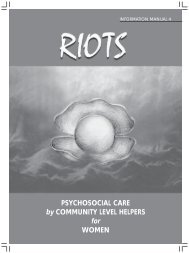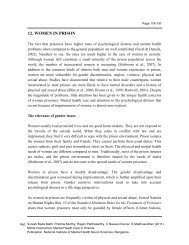An illicit alcohol production center in rural Bangalore - Nimhans
An illicit alcohol production center in rural Bangalore - Nimhans
An illicit alcohol production center in rural Bangalore - Nimhans
Create successful ePaper yourself
Turn your PDF publications into a flip-book with our unique Google optimized e-Paper software.
f. Subjective perception of dr<strong>in</strong>k related problems<br />
The predom<strong>in</strong>ant dr<strong>in</strong>k<strong>in</strong>g related problems reported, were economic. Physical ill health and<br />
problems at work, even problems <strong>in</strong> the family related to <strong>alcohol</strong> use were not perceived as major<br />
problems. The dra<strong>in</strong> on economic resources among consumers is understandable as consumers, on<br />
average, apparently spent more than one fourth of their family <strong>in</strong>come on buy<strong>in</strong>g <strong>alcohol</strong>. The<br />
impact of <strong>alcohol</strong> spend<strong>in</strong>g on family <strong>in</strong>come was greater among <strong>rural</strong> consumers than urban<br />
consumers.<br />
The impact of <strong>alcohol</strong> use [and heavy <strong>alcohol</strong> use at that] on physical health is clearly m<strong>in</strong>imized.<br />
Independent evidence from another study on <strong>alcohol</strong> and <strong>in</strong>juries conducted <strong>in</strong> the same population,<br />
dur<strong>in</strong>g the same time w<strong>in</strong>dow, estimated that nearly 60% of all <strong>in</strong>juries present<strong>in</strong>g to the largest<br />
medical emergency department <strong>in</strong> the state, were <strong>alcohol</strong> related. Data from this study revealed that<br />
the major proportion of <strong>in</strong>jury was due to someone else’s dr<strong>in</strong>k<strong>in</strong>g and that the largest proportion of<br />
these <strong>in</strong>juries comprised violent <strong>in</strong>juries. Earlier studies of dr<strong>in</strong>k<strong>in</strong>g <strong>in</strong> temperance cultures have<br />
highlighted the strongly held belief that <strong>alcohol</strong> use is expected to lead to <strong>in</strong>toxication, dis<strong>in</strong>hibition<br />
and violence.<br />
It is not surpris<strong>in</strong>g that more than 15% of all users had experience of problems due to other people’s<br />
<strong>alcohol</strong> use, most of which was violent <strong>in</strong> nature.<br />
Hazardous dr<strong>in</strong>k<strong>in</strong>g is observed <strong>in</strong> 80% of all consumers<br />
All the above factors add up to a predom<strong>in</strong>ant pattern of hazardous use. 80% of all consumers (80%<br />
of male consumers and 65% of female consumers were clearly dr<strong>in</strong>k<strong>in</strong>g at hazardous levels. This is<br />
a strong re-iteration of earlier f<strong>in</strong>d<strong>in</strong>gs <strong>in</strong> this same population as also from the rest of the country<br />
that more than one out of two people who dr<strong>in</strong>k, do so at hazardous levels.<br />
The heavy dr<strong>in</strong>kers were more likely to dr<strong>in</strong>k multiple beverages. Those who drank multiple<br />
beverages had significantly lower <strong>in</strong>come, less education, greater occurrence of hazardous dr<strong>in</strong>k<strong>in</strong>g<br />
patterns, and spent a larger proportion of their <strong>in</strong>come <strong>in</strong> buy<strong>in</strong>g <strong>alcohol</strong>. It is not surpris<strong>in</strong>g that a<br />
greater proportion of their consumption, belonged to the <strong>illicit</strong>/undocumented variety, because of<br />
the price advantage.<br />
5. Alcohol and health<br />
There is<br />
significant<br />
<strong>alcohol</strong> related<br />
health damage <strong>in</strong><br />
consumers<br />
Alcohol users<br />
were more likely<br />
to have had a<br />
significant illness<br />
<strong>in</strong> the previous<br />
year than people<br />
who were<br />
abst<strong>in</strong>ent.<br />
Heavy dr<strong>in</strong>kers<br />
(those who drank<br />
more than 5<br />
standard dr<strong>in</strong>ks<br />
per representative<br />
16<br />
14<br />
12<br />
10<br />
8<br />
6<br />
4<br />
2<br />
0<br />
Absta<strong>in</strong>e<br />
7.3<br />
Alcohol Use and Illness<br />
15.3 15.1<br />
Significant Illness <strong>in</strong> the last year<br />
15.6<br />
Alcohol User < 5 dr<strong>in</strong>ks > 5 dr<strong>in</strong>ks<br />
83





